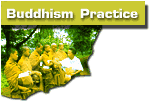 |
BANGKOK
|
||||||||
CENTRAL
|
||||||||||||
NORTHEASTERN
|
||||||||||||||
NORTHERN
|
||||||||||||
SOUTHERN
|
||||
 |
| A GUIDE TO MEDITATION CENTRES IN THAILAND |
| CENTRAL - SUNNATARAM FOREST MONASTERY |
MEANING
OF NAME : |
"Pure mind forest monastery" |
ALSO
SPELLED : |
Samnak Pah Sunyataram |
ADDRESS
: |
Ban Kroeng Kra Wia, Tambon Prang Phea, Ampher Sangkhla Buri, Kanchanaburi 71180 |
DIRECTIONS
: |
Located 302 km northwest of Bangkok. Take a train (from Bangkok Noi Station) or bus (from Southern or Southern AC bus terminals) west 128 km to Kanchanaburi, then hop on a bus or minibus bound for Sangkhla Buri; ask to be let off at the monastery, which is 174 km from Kanchanaburi and 42 km before Sangkhla Buri, between KM posts 32 and 33 on Hwy. 323. The monastery is just east of the highway. |
MEDITATION
SYSTEM : |
Anapanasati and metta. |
TEACHING
METHOD : |
Dhamma talks by senior monks. Tapes of Phra Ajahn Yantra are often played during the evening meditation period. He and other senior monks will answer questions. |
TEACHERS
: |
Senior monks. The teacher travels extensively and may be gone most of the time. He is highly respected for his metta and skill at teaching meditation. People also look up to him as a good example of how one can be happy despite life's difficulties. |
LANGUAGE
: |
A few other monks can speak some English. |
DESCRIPTION
: |
The monastery covers 280 rai (112 acres) in a beautiful forested valley enclosed by steep mountains. This karst area has many sinkholes, caves, and strange-shaped rocks. Phra Ajahn Yantra discovered the site while on tudong, then founded the monastery in 1984. A small river flows through the valley, separating the women's and sangha areas. On entering the monastery, you'll pass the women's area on the right, then cross a bridge to the sangha area; monks greet visitors at a small sala just past road's end. Except on wan phra , the rest of the sangha area is normally closed to nonresidents. Phra Ajahn Yantra's kuti is perched highatop a rock pinnacle; ask if you can visit. Caves near the monastery can be used for meditation. |
SIZE
: |
monks:
10-100 novices: 5-20 nuns: about 30 laywomen: 30-50 laymen: 5-10 |
DAILY
ROUTINE : |
3:30 a.m. wakeup; 4-6 a.m. chanting and meditation; about 6 a.m. monks and novices go on a long 6-km pindabat; 8:30 a.m. monks and novices go on a second pindabat within the monastery; 9 a.m. chanting (reflection on food) and meditation for about 30 min., followed by the meal; 3 p.m. work period; about 4 p.m. drink; 6-8 p.m. chanting (about one hour) and meditation; 8 p.m. sometimes a senior monk gives a talk. |
FOOD
: |
Vegetarian of good quality and variety. Monks and novices go on pindabat for rice; laypeople at the monastery reoffer the rice and offer food prepared in the kitchen. A large garden beyond the women's kutis provides much of the community's requirements. Unusual for Thailand, the monastery and its branches take only vegetarian food as part of a metta practice. |
ACCOMMODATIONS
: |
Individual kutis of various sizes and materials in both the sangha and womens areas; some have screens. When many visitors are expected, as during the Rains Retreat and when Phra Ajahn Yantra stays, simple bamboo kutis are built. Laypeople can stay in kutis, if available. Laymen who follow 8 precepts can stay in the sangha area. Only larger buildings have electricity and running water. Thai-style bathrooms (men can also use a bathing stream in the sangha area); Asian-style toilets. |
WRITE
IN ADVANCE? : |
Not necessary. Expect crowded conditions during the Rains Retreat and when Phra Ajahn Yantra is in residence; it's a good idea to visit a month or more ahead of these times to arrange accommodation. Groups should write in advance any time. |
OTHER
INFORMATION : |
Malaria
exists here, so it's important to use netting and insect repellent.
A small library has some English books. Laypeople who follow 8 precepts
wear white clothing. The monastery welcomes all traditions of Buddhist
monks and laypeople. Visiting monks who follow strict Vinaya can sit
with resident monks for eating and daily chantings. Residents follow a strict forest tradition practice. Nearly all monks go on tudong after the Rains Retreat ends;some monks make a resolution to travel only by foot for a certain time. Populations at this monastery and its branches fluctuate greatly because of the tudong practice. Branch monasteries offer excellent conditions for meditation practice too; they can usually accommodate small numbers of visitors. Some English may be spoken at Tham Wua and Wat Sab-Chan. KOW KAEW SUNNATARAM on an island in nearby Khao Laem Reservoir offers much solitude; first ask permission to stay from the main monastery. In northwestern Thailand, THAM WUA SUNNATA has caves and a spectacular setting beneath sheer limestone cliffs; it's located about 45 km north of Mae Hong Son, then 1.5 km in by dirt road or trail (Ban Mae Su Ya, Tambon Huai Pha, Amphoe Muang, Mae Hong Son 58000). In eastern Thailand, WAT SAB-CHAN (SUNNATARAM) lies in a valley surrounded by fruit orchards and forested hills 27 km west of Chanthaburi, then 2 km in by road (Tambon Na Yai Arm, Amphoe Tha Mai, Chanthaburi 22160). In central Thailand, DHAMMALEELA MEDITATION CENTER is surrounded by a golf course 40 km northeast of Bangkok (Klong 14 Rangsit, Tambon Bang Pla Kot, Amphoe Ongkharak, Nakhon Nayok 26120). |
| Select here : |
|
|